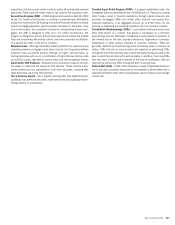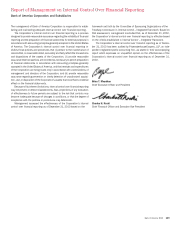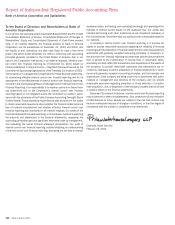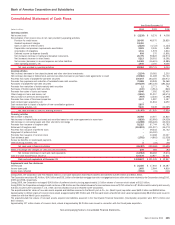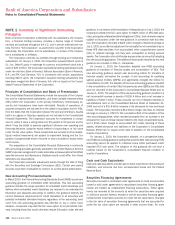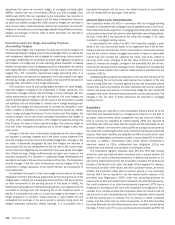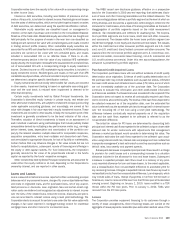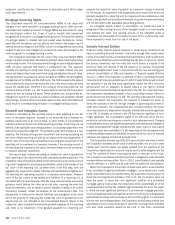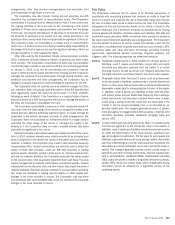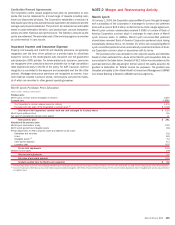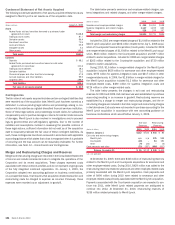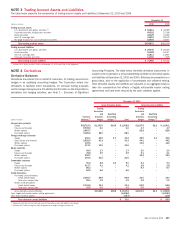Bank of America 2010 Annual Report Download - page 149
Download and view the complete annual report
Please find page 149 of the 2010 Bank of America annual report below. You can navigate through the pages in the report by either clicking on the pages listed below, or by using the keyword search tool below to find specific information within the annual report.information on securities financing agreements that the Corporation accounts
for under the fair value option, see Note 23 – Fair Value Option.
The Corporation’s policy is to obtain possession of collateral with a market
value equal to or in excess of the principal amount loaned under resale
agreements. To ensure that the market value of the underlying collateral
remains sufficient, collateral is generally valued daily and the Corporation may
require counterparties to deposit additional collateral or may return collateral
pledged when appropriate. Securities financing agreements give rise to neg-
ligible credit risk as a result of these collateral provisions, and accordingly, no
allowance for loan losses is considered necessary.
Substantially all repurchase and resale activities are transacted under
master repurchase agreements which give the Corporation, in the event of
default by the counterparty, the right to liquidate securities held and to offset
receivables and payables with the same counterparty. The Corporation offsets
repurchase and resale transactions with the same counterparty on the Con-
solidated Balance Sheet where it has such a master agreement and the
transactions have the same maturity date.
In transactions where the Corporation acts as the lender in a securities
lending agreement and receives securities that can be pledged or sold as
collateral, it recognizes an asset on the Consolidated Balance Sheet at fair
value, representing the securities received, and a liability for the same
amount, representing the obligation to return those securities.
At the end of certain quarterly periods during the three years ended
December 31, 2009, the Corporation had recorded certain sales of agency
mortgage-backed securities (MBS) which, based on an ongoing internal review
and interpretation, should have been recorded as secured borrowings. These
periods and amounts were as follows: March 31, 2009 – $573 million;
September 30, 2008 – $10.7 billion; December 31, 2007 – $2.1 billion; and
March 31, 2007 – $4.5 billion. As the transferred securities were recorded at
fair value in trading account assets, the change would have had no impact on
consolidated results of operations. Had the sales been recorded as secured
borrowings, trading account assets and federal funds purchased and secu-
rities loaned or sold under agreements to repurchase would have increased by
the amount of the transactions, however, the increase in all cases was less
than 0.7 percent of total assets or total liabilities. Accordingly, the Corporation
believes that these transactions did not have a material impact on the
Corporation’s Consolidated Financial Statements.
In repurchase transactions, typically, the termination date for a repur-
chase agreement is before the maturity date of the underlying security.
However, in certain situations, the Corporation may enter into repurchase
agreements where the termination date of the repurchase transaction is the
same as the maturity date of the underlying security and these transactions
are referred to as “repo-to-maturity” (RTM) transactions. The Corporation
enters into RTM transactions only for high quality, very liquid securities such
as U.S. Department of the Treasury (U.S. Treasury) securities or securities
issued by government-sponsored enterprises (GSE). The Corporation ac-
counts for RTM transactions as sales in accordance with applicable account-
ing guidance, and accordingly, removes the securities from the Consolidated
Balance Sheet and recognizes a gain or loss in the Consolidated Statement of
Income. At December 31, 2010, the Corporation had no outstanding RTM
transactions compared to $6.5 billion at December 31, 2009, that had been
accounted for as sales.
Collateral
The Corporation accepts collateral that it is permitted by contract or custom to
sell or repledge and such collateral is recorded on the Consolidated Balance
Sheet. At December 31, 2010 and 2009, the fair value of this collateral was
$401.7 billion and $418.2 billion of which $257.6 billion and $310.2 billion
were sold or repledged. The primary sources of this collateral are repurchase
agreements and securities borrowed. The Corporation also pledges securities
and loans as collateral in transactions that include repurchase agreements,
securities loaned, public and trust deposits, U.S. Treasury tax and loan notes,
and other short-term borrowings. This collateral can be sold or repledged by
the counterparties to the transactions.
In addition, the Corporation obtains collateral in connection with its de-
rivative contracts. Required collateral levels vary depending on the credit risk
rating and the type of counterparty. Generally, the Corporation accepts col-
lateral in the form of cash, U.S. Treasury securities and other marketable
securities. Based on provisions contained in legal netting agreements, the
Corporation nets cash collateral against the applicable derivative fair value.
The Corporation also pledges collateral on its own derivative positions which
can be applied against derivative liabilities.
Trading Instruments
Financial instruments utilized in trading activities are carried at fair value. Fair
value is generally based on quoted market prices or quoted market prices for
similar assets and liabilities. If these market prices are not available, fair
values are estimated based on dealer quotes, pricing models, discounted
cash flow methodologies, or similar techniques where the determination of
fair value may require significant management judgment or estimation. Re-
alized and unrealized gains and losses are recognized in trading account
profits (losses).
Derivatives and Hedging Activities
Derivatives are entered into on behalf of customers, for trading, as economic
hedges or as qualifying accounting hedges. Derivatives utilized by the Corpo-
ration include swaps, financial futures and forward settlement contracts, and
option contracts. A swap agreement is a contract between two parties to
exchange cash flows based on specified underlying notional amounts, assets
and/or indices. Financial futures and forward settlement contracts are agree-
ments to buy or sell a quantity of a financial instrument, index, currency or
commodity at a predetermined future date, and rate or price. An option
contract is an agreement that conveys to the purchaser the right, but not
the obligation, to buy or sell a quantity of a financial instrument (including
another derivative financial instrument), index, currency or commodity at a
predetermined rate or price during a period or at a date in the future. Option
agreements can be transacted on organized exchanges or directly between
parties.
All derivatives are recorded on the Consolidated Balance Sheet at fair
value, taking into consideration the effects of legally enforceable master
netting agreements that allow the Corporation to settle positive and negative
positions and offset cash collateral held with the same counterparty on a net
basis. For exchange-traded contracts, fair value is based on quoted market
prices. For non-exchange traded contracts, fair value is based on dealer
quotes, pricing models, discounted cash flow methodologies or similar tech-
niques for which the determination of fair value may require significant
management judgment or estimation.
Valuations of derivative assets and liabilities reflect the value of the
instrument including counterparty credit risk. These values also take into
account the Corporation’s own credit standing, thus including in the valuation
of the derivative instrument the value of the net credit differential between the
counterparties to the derivative contract.
Trading Derivatives and Economic Hedges
Derivatives held for trading purposes are included in derivative assets or
derivative liabilities with changes in fair value included in trading account
profits (losses).
Derivatives used as economic hedges, because either they did not qualify
for or were not designated as an accounting hedge, are also included in
derivative assets or derivative liabilities. Changes in the fair value of
Bank of America 2010 147


